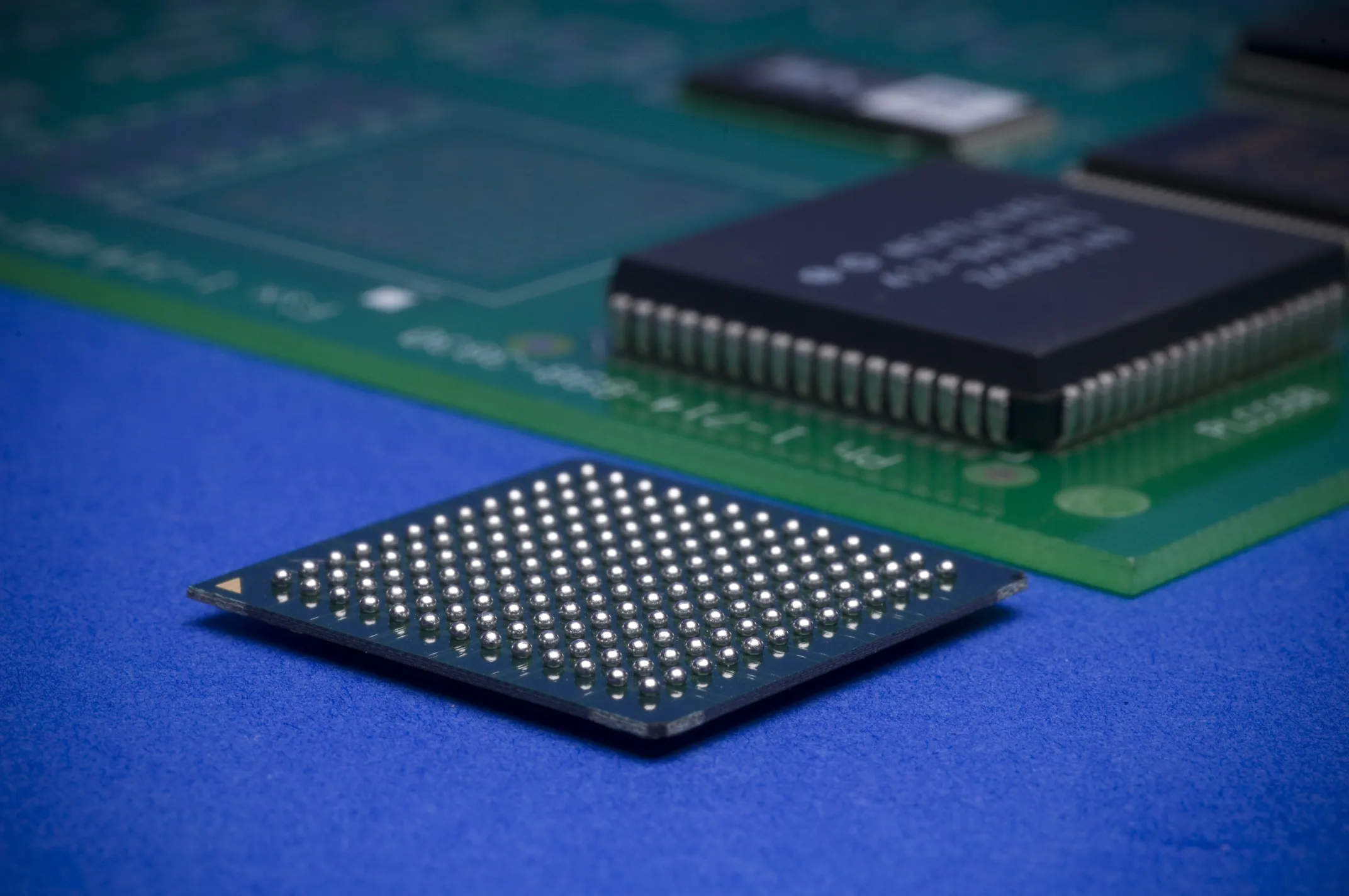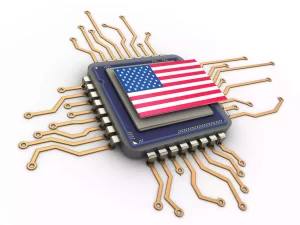Introduction:
In the dynamic world of semiconductor innovation, the packaging of integrated circuits (ICs) plays a pivotal role in determining the success of electronic devices. As technology evolves, so does the need for more efficient and compact packaging solutions. One such groundbreaking advancement that has gained prominence is Flip Chip Technology.
Flip chip technology is a packaging technique used in the electronics industry to connect semiconductor devices (such as integrated circuits or chips) to substrates (such as printed circuit boards or other chips).
In a traditional chip packaging approach, the electrical connections on the chip are bonded to the package substrate using wire bonds. In flip chip technology, the chip is flipped upside down, and the electrical connections are made directly through solder bumps or balls.
This blog explores the essence of IC packaging through the lens of flip chip, unraveling its history, nomenclature, and how it overcomes the limitations posed by traditional wire bonding.
Join Our WhatsApp News for updated information on semiconductors & AI
How Flip Chip Technology Got Its Name:
The name “flip chip” is derived from the process itself. During manufacturing, the IC is flipped upside down, and the active side is precisely aligned and connected to the substrate. This innovative approach has become synonymous with increased performance and miniaturization in semiconductor packaging.
Read More: AI Chipset Market : Size, Share, and Trends For Next Decade – techovedas
History:
Flip chip technology was first introduced by IBM in 1962. The technology was first introduced for ceramic substrates (solid logic technology). Solid logic tech was a way of making electronic circuits on ceramic plates.
It was converted to C4 (Controlled Collapse Chip Technology) for ICs in 1970. However, it wasn’t until the 1990s that flip chip gained widespread acceptance due to advancements in manufacturing processes and materials. As electronic devices continued to shrink in size while demanding higher performance, flip chip emerged as a revolutionary solution to meet these evolving requirements. Now every laptop, mobile, tablet, smartwatch etc. uses flip chip technology for IC packaging.
An analogy to understand Flip Chip technology
Imagine you have a puzzle with intricate pieces that need to be connected to a base. In the traditional approach (like wire bonding), you’d use tiny strings to link each puzzle piece to its place on the base. However, this method has limitations in terms of speed and efficiency.
Now, think of flip chip technology as a more streamlined method. Instead of strings, each puzzle piece has small magnetic points (analogous to solder bumps) on its underside. You simply flip each piece upside down and attach it directly to the corresponding magnetic spots on the base. The direct connection is not only faster but also more efficient because the pieces are now much closer to the base, minimizing the distance each signal needs to travel.
In this analogy:
- The puzzle pieces represent semiconductor chips.
- The base represents the substrate (like a circuit board).
- The strings represent wire bonds in traditional packaging.
- The magnetic points represent solder bumps in flip chip technology.
So, flip chip technology is like directly placing puzzle pieces with magnetic connections, providing a faster and more efficient way to complete the puzzle compared to the traditional method of using strings.
Why Flip Chip Technology? – Wire Bonding and Its Limitations:
To understand the significance of flip chip technology, it’s essential to acknowledge the traditional method of wire bonding.
Wire bonding
In wire bonding, tiny wires are used to connect the IC to the substrate, forming electrical pathways. While wire bonding has been a reliable packaging technique, it does have its limitations. Wire bonding limitations include increased inductance, longer signal paths, and lower thermal conductivity.
These factors can hinder the overall performance and reliability of the IC, especially in applications that require high-speed data transfer and compact form factors.
Read More: 3 Ways Artificial Intelligence (AI) is Revolutionizing Semiconductor Industry
Flip Chip Technology – The process
Achieving flip chip packaging involves a meticulous process that optimizes the connection between the integrated circuit (IC) and the substrate. The key steps can be summarized in the following concise description:
- Fluxing: Imagine preparing a canvas for a painting. Fluxing is like cleaning the canvas, removing any dust or imperfections. In flip chip tech, it’s about applying a special cleaner (flux) on the chip to make sure it’s ready for the next steps.

- Die Placement: Now, think of placing puzzle pieces perfectly. Die placement is like putting the main piece (the chip) onto the board, making sure all the parts fit snugly, usually done with a robotic arm for precision.

- Reflow: Let’s add a bit of magic! Reflow is like using a gentle heat to make the puzzle pieces stick together. The tiny solder bits on the chip melt, creating a solid bond with the board.

- Flux Cleaning: After the magic, there might be some leftover glitter (flux residues). Flux cleaning is the tidy-up step. We use a special cleaner to wipe away any leftover bits, ensuring our puzzle looks neat and clean.

- Underfill: Now, we want to make our puzzle sturdy. Underfill is like adding glue around the edges. We pour a special liquid to fill any gaps and protect our puzzle from getting wobbly.

- Cure: Our glue needs time to get strong. Curing is like letting our puzzle dry. We might use heat or light to make the liquid glue harden, ensuring our puzzle stays together and strong for a long time.
Read More: Deepsouth Awakens: The Human Brain-Scale Supercomputer Coming in 2024 – techovedas
How Does Flip Chip Address the Limitations of Wire Bonding:
One of the limitations of wire bonding that flip chip technology addresses is the issue of electrical performance, especially in high-frequency and high-speed applications. Here are some key points illustrating how flip chip technology overcomes this limitation:
Inductance:
- Wire Bonding: In wire bonding, the wires (or bonds) used to connect the semiconductor chip to the substrate introduce inductance. Inductance is a property that resists changes in current flow, and it can lead to signal delays and reduced performance, especially at high frequencies.
- Flip Chip Technology: By flipping the chip and using solder bumps for direct connections, flip chip technology significantly reduces the inductance. The shorter path and direct connection result in improved signal integrity, making flip chip technology suitable for high-frequency applications.
Signal Path Length:
- Wire Bonding: The length of the wire bonds in traditional packaging can be relatively long, especially in comparison to the compact size of modern semiconductor devices. This increased length can lead to higher resistance and capacitance, affecting the overall performance of the chip.
- Flip Chip Technology: The direct attachment of the chip to the substrate in flip chip technology minimizes the length of the signal path, reducing resistance and capacitance. This shorter path contributes to improved electrical performance and signal transmission.
High-Density Packaging:
- Wire Bonding: Wire bonding may become more challenging as the density of electronic components on a chip increases. The fine wires used in bonding may not scale well with the decreasing size of modern semiconductor devices.
- Flip Chip Technology: High-density packaging is achievable with flip chip technology because it enables the reduction in size of solder bumps and the accommodation of finer pitches. This proves particularly advantageous in advanced integrated circuits where space is a premium factor.
Thermal Performance:
- Wire Bonding: The indirect nature of wire bonding may limit the efficiency of heat dissipation from the chip to the substrate.
- Flip Chip Technology: The direct attachment of the chip to the substrate in flip chip packaging enhances thermal performance, as heat generated by the chip can be more efficiently conducted away through the solder bumps.
In summary, flip chip technology addresses the limitations of wire bonding by providing a more direct, shorter, and efficient electrical connection, leading to improved electrical performance, especially in high-frequency and high-density applications.
Latest Research in Flip Chip:
Researchers are exploring new materials for bumping (gold balls), underfilling, and substrate construction to enhance the overall efficiency of flip chip packaging.
Silicon Quantum Dots (SQDs): SQDs are a type of nanomaterial that is being used in flip chip technology as an alternative to traditional silicon devices. They have superior performance and offer a new platform for next- generation electronic devices.
Flip chip solutions enhance device performance and power efficiency by integrating multiple chips on one substrate. They’re beneficial for emerging technologies like 5G, AI, and IoT.
5G requires high-performance computing chips that can handle massive data processing and communication tasks. Flip chip solutions can provide a compact and efficient way to integrate these chips with other components, such as memory, sensors, and antennas. For example, Qualcomm Technologies has developed a flip chip solution called QCS6490 that combines a 5G modem with an AI accelerator on a single package.
Flipchip in AI hardware – Training AI requires a lot of parameters and to feed parameters we need high bandwidth data transfer between compute unit and memory. Researchers have proposed a flip chip solution called CoWoS (chip-on-wafer-on-substrate) that integrates logic computing and high-bandwidth memory (HBM) chips on a silicon interposer.
Conclusion:
In conclusion, flip chip technology represents a paradigm shift in the world of IC packaging. Its ability to overcome the limitations of traditional wire bonding has made it a go-to solution for high-performance electronic devices. As we delve deeper into the era of miniaturization and heightened technological demands, flip chip technology stands as a beacon of innovation, driving the semiconductor industry toward unprecedented possibilities.









